UMass Extension's Landscape Message is an educational newsletter intended to inform and guide Massachusetts Green Industry professionals in the management of our collective landscape. Detailed reports from scouts and Extension specialists on growing conditions, pest activity, and cultural practices for the management of woody ornamentals, trees, and turf are regular features. The following issue has been updated to provide timely management information and the latest regional news and environmental data.
The Landscape Message will be updated weekly in May. The next message will be posted on May 13. To receive immediate notification when the next Landscape Message update is posted, be sure to join our e-mail list
To read individual sections of the message, click on the section headings below to expand the content:
Scouting Information by Region
Environmental Data
The following data was collected on or about May 4, 2022. Total accumulated growing degree days (GDD) represent the heating units above a 50° F baseline temperature collected via regional NEWA stations (http://newa.cornell.edu) for the 2022 calendar year. This information is intended for use as a guide for monitoring the developmental stages of pests in your location and planning management strategies accordingly.
|
MA Region/Location |
GDD |
Soil Temp |
Precipitation |
Time/Date of Readings |
|||||
|
1-Week Gain |
2022 Total |
Sun |
Shade |
||||||
|
CAPE |
0 |
32 (BE 104) |
51 |
49 |
0.69 |
12:00 PM 5/04 |
|||
|
SOUTHEAST |
5.5 |
70 |
55 |
51 |
0.76 |
3:00 PM 5/04 |
|||
|
NORTH SHORE |
0 |
47 |
51 |
47 |
0.42 |
12:00 PM 5/04 |
|||
|
EAST |
6 |
80 |
52 |
50 |
0.4 |
4:00 PM 5/4 |
|||
|
METRO |
4 |
51 |
50 |
47 |
0.21 |
5:30 AM 5/4 |
|||
|
CENTRAL |
4 |
41 |
50 |
48 |
0.29 |
6:30 AM 5/4 |
|||
|
PIONEER VALLEY |
5.5 |
49 |
55 |
49 |
0.61 |
4:00 PM 5/4 |
|||
|
BERKSHIRES |
1 |
33 |
52 |
48 |
0.35 |
7:30 AM 5/4 |
|||
|
AVERAGE |
3 |
50 |
52 |
49 |
0.46 |
_ |
|||
|
* = information not available |
|||||||||
Phenology
| Indicator Plants - Stages of Flowering (BEGIN, BEGIN/FULL, FULL, FULL/END, END) | ||||||||
|---|---|---|---|---|---|---|---|---|
| PLANT NAME (Botanic / Common) | CAPE | S.E. | N.S. | EAST | METRO W. | CENT. | P.V. | BERK. |
|
Syringa vulgaris (common lilac) |
Begin |
Begin |
Begin |
Begin |
* |
* |
Begin |
* |
|
Cornus florida (flowering dogwood) |
Begin |
Full |
Begin |
Begin |
Begin |
Begin |
Begin |
* |
|
Rhododendron spp.(early azaleas) |
Begin |
* |
Begin |
* |
* |
Begin |
Begin |
* |
|
Malus spp. (crabapple) |
Begin/Full |
Full |
Begin |
Begin |
Begin |
Begin |
Full |
Begin |
|
Cercis canadensis (redbud) |
Begin/Full |
Begin/Full |
Begin |
Begin/Full |
Begin/Full |
Begin |
Begin/Full |
* |
|
Rhododendron 'P. J. M.' |
Full/End |
Full/End |
Full |
Full/End |
Full/End |
Full/End |
Full/end |
Full |
|
Amelanchier spp. (shadbush, serviceberry) |
Full |
End |
Full/End |
Full/End |
Full |
Full |
Full/End |
Begin/Full |
|
Magnolia soulangiana (saucer Magnolia) |
End |
End |
Full/End |
Full/End |
Full/End |
Full/End |
Full/End |
Full/End |
| * = no activity to report/information not available | ||||||||
Regional Notes
Cape Cod Region (Barnstable)
General Conditions: The average temperature for the period from April 27 through May 4 was 48ᣞF with a low of 37ᣞF on April 30 and May 1 and a high of 62ᣞF also on May 1. Frost was seen on the morning of April 30 in low areas of the upper Cape. Overall, the period was split between sunny days early in the period and cloudy days late in the period. Just over a half inch of precipitation fell during the period on May 2nd and 3rd. Conditions have been very breezy. Herbaceous plants seen in bloom during the period include daffodil (Narcissus spp.), tulip (Tulipa spp.), grape hyacinth (Muscari armeniacum), creeping phlox (Phlox subulata), bleeding heart (Dicentra spectabilis and D. eximia), yellow alyssum (Aurinia saxatilis), lungwort (Pulmonaria officinalis), barrenwort ( Epimedium spp.), and little merry bells, sessile bellwort (Uvularia sessilifolia). Woody plants in bloom include callery pear (Pyrus calleryana), crabapple (Malus spp.), Korean spice viburnum (Viburnum carlesii), serviceberry (Amelanchier canadensis), redbud (Cercis canadensis), Japanese cherry ‘Kwanzan’ (Prunus serrulata ‘Kwanzan’) is beginning bloom while forsythia is just about finished.
Pests/Problems: Winter moth has hatched and was found feeding in the buds of rose, blueberry and apple. Winter moth is no longer considered an important forest pest on the Cape nor is it likely to impact the health of ornamentals and thus no longer requires widespread management. Control may be required for fruit bearing apples and blueberries. White pine needle disease can be seen on white pine (P. strobus) and needlecast can also be seen on pitch pine (P. rigida). Damage from the previous growing season on boxwood (leafminer damage) and on andromeda (lacebug) are apparent. Weeds in bloom include hairy bittercress (Cardamine hirsuta), mouse-ear cress (Arabidopsis thaliana), yellow rocket (Barbarea vulgaris), shepherd's purse (Capsella bursa-pastoris), thymeleaf speedwell (Veronica serpyllifolia), fig buttercup (Ficaria verna), garlic mustard (Allaria petiolata), dandelion (Taraxcum officinale), common violet (Viola sororia), and cypress spurge (Euphorbia cyparissias).
Southeast Region (Dighton)
General Conditions: We've had lovely spring weather over the past week albeit a few days were on the cooler side and breezy. My full sun soil temperature reading actually cooled by several degrees from the previous week.The first flush of dandelions have already gone to seed and their pappus are parachuting on the frequent winds. Peaches are at "shuck" stage. Cranefly adults are numerous. Plants in flower include: Aquilegia spp. (columbine), Chaenomeles superba x speciosa (flowering quince), Deutzia sp., Forsythia x intermedia (border Forsythia), Geranium maculatum (cranesbill), Halesia carolina (Carolina silverbell), Iberis sempervirens (candytuft), Lamprocapnos spectabilis (bleeding heart), Leucojum aestivum (summer snowflake), Lunaria annua (honesty), Malus spp. (apple, crabapple), Muscari (grape hyacinth), Narcissus spp. (daffodils), Phlox stolonifera (creeping phlox), Pieris japonica (Japanese andromeda), Prunus maritima (beach plum), P. 'Kanzan' (Kwanzan cherry), Rhododendron carolina (Carolina rhododendron), R. 'P.J.M', Syringa vulgaris (common lilac), Tulipia, Trillium grandiflorum (white trillium), T. sessile (toadshade), Viburnum carlesii (Korean all-spice viburnum).
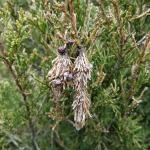

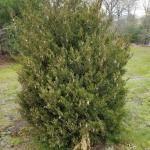 Pests/Problems: I've recently discovered a second population of bagworms from last year within a mile of the last. One infestation was in Berkley on juniper, the other was in Dighton on winged euonymus. It's not apparent yet if they overwintered but given the mild winter it might be prudent to add bagworm to your list of new insects to monitor. Weeds are emerging in every untended corner. Hedge bindweed (Calystegia sepium) is already half a foot long. Alliaria petiolata (garlic mustard) should be pulled and bagged before it goes to seed. Poison ivy leaves are approximately one inch long and dark red. Ticks are active and hungry.
Pests/Problems: I've recently discovered a second population of bagworms from last year within a mile of the last. One infestation was in Berkley on juniper, the other was in Dighton on winged euonymus. It's not apparent yet if they overwintered but given the mild winter it might be prudent to add bagworm to your list of new insects to monitor. Weeds are emerging in every untended corner. Hedge bindweed (Calystegia sepium) is already half a foot long. Alliaria petiolata (garlic mustard) should be pulled and bagged before it goes to seed. Poison ivy leaves are approximately one inch long and dark red. Ticks are active and hungry.
North Shore (Beverly)
General Conditions: Below normal temperatures persisted during this reporting period. Day temperatures were in the low to mid 50s most days except on Tuesday, May 1, when temperatures went up to 62˚ F. Night temperatures were mostly in the mid 30s to mid 40s. The average daily temperature was 53˚F, with a minimum temperature of 35˚F recorded on May 1 and a maximum temperature of 62˚F also recorded on May 1. Approximately 0.42 inches of rain were recorded at Long Hill. Soils are moist and suitable for planting, lawns are green and turf is thriving. Some groups in the area are offering spring plant sales this weekend. In addition to the plants reported in the Phenology chart above, other woody plants in full bloom include: mountain pieris (Pieris floribunda), royal azalea (Rhododendron schlippenbachii), Kwanzan cherry (Prunus serrulata), burkwood viburnum (Viburnum x burkwoodii), Cornell pink Korean Rhododendron (Rhododendron mucronulatum), and highbush blueberry (Vaccinium corymbosum). Non-woody plants seen in bloom include: hellebores (Helleborus orientalis), daffodil (Narcissus spp.), forget-me-not (Myosotis sylvatica), tulips (Tulipa spp.), bleeding heart (Lamprocapnos spectabilis), Allegheny spurge (Pachysandra procumbens), vinca vine (Vinca minor) and white trillium (Trillium grandiflorum).
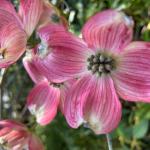
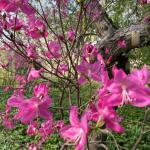
 Pests/Problems: Invasive garlic mustard (Alliaria petiolata) is in full bloom. Other weeds in bloom include: common blue violet (Viola papilionacea), dandelion (Taraxacum officinale), lesser celandine (Ranunculus ficaria), ground ivy (Glechoma hederacea) and purple deadnettle (Lamium purpureum). Symptoms of likely Volutella blight (Pseudonectria pachysandricola) was observed on a small patch of pachysandra. No insect pest activity was observed. However, remember that ticks are very active. Protect yourself with repellent when working outdoors.
Pests/Problems: Invasive garlic mustard (Alliaria petiolata) is in full bloom. Other weeds in bloom include: common blue violet (Viola papilionacea), dandelion (Taraxacum officinale), lesser celandine (Ranunculus ficaria), ground ivy (Glechoma hederacea) and purple deadnettle (Lamium purpureum). Symptoms of likely Volutella blight (Pseudonectria pachysandricola) was observed on a small patch of pachysandra. No insect pest activity was observed. However, remember that ticks are very active. Protect yourself with repellent when working outdoors.
East Region (Boston)
General Conditions: We had another week of cool weather. Temperatures averaged 57ᣞF with overnight lows averaging 41ᣞF. As of Saturday April 30 we had eight straight days with temperatures below average. It had been 14 months since we recorded eight consecutive days with below average temperatures. We did have a top ten weather day on Sunday May 1 with sunny skies and a high of 69ᣞF. April total rainfall was 2.83 inches, approximately one inch below average. Plants in bloom include; Akebia quintata (three leaf Akebia), Erythronium ‘Pagoda’ (dog tooth violet), Phlox subulata (creeping phlox) and Pachysandra terminalis (Japanese pachysandra). Not often seen in the trade, Prunus maackii (amur chokecherry) is in 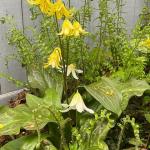
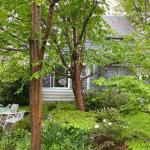 full bloom and notable for its beautiful cinnamon colored bark. Spring migrant birds are returning to the area including orioles, hummingbirds and warblers. Some less showy migratory birds are also on the move, with brown thrashers and catbirds returning, while many juncos have already made their pitstop and are continuing northward.
full bloom and notable for its beautiful cinnamon colored bark. Spring migrant birds are returning to the area including orioles, hummingbirds and warblers. Some less showy migratory birds are also on the move, with brown thrashers and catbirds returning, while many juncos have already made their pitstop and are continuing northward.
Pests/Problems: Soils remain relatively dry. Many early emerging Allium spp. (ornamental onion) foliage has damaged tips likely a result of cold temperatures. Hydrangea leaftier (Olethreutes ferriferana) has begun knitting the foliage of H. ‘Annabel’. You can manually remove the caterpillars at this time. Landscape weeds in flower include; Alliaria petiolata (garlic mustard), Barbarea vulgaris (yellow rocket), Ficaria verna (lesser celandine), Glechoma hederacea (ground ivy) and Taraxacum officianalis (dandelion). Polygonum cuspidatum (Japanese knotweed) is gaining size daily and can be seen forming masses along roadsides.
Metro West (Acton)
General Conditions: Weather is typical for this time of the year and for a New England spring with varying temperatures from one day to the next, warm one day, cool the next, calm and/or windy days and nights, and the occasional rainy, gloomy, damp weather. The wind has been relentless with a wind gust recorded at 36 mph this past Thursday morning and a gust of 26 mph on Arbor Day. The average rainfall total for the month of April is 4.16” and I closed out that month with a total of 3.35” of rain recorded. According to NOAA, the 20-year average rainfall total for the month of May is 3.37”and total precipitation recorded for the month so far is 0.19”. For this past week, a high temperature of 72°F was recorded over the weekend on May 1st and a low of 34°F was recorded on that same day and on the 30th. In addition to what is reported in the Phenology chart, woody plants seen in bloom this past week are Chaenomeles speciosa (common flowering quince), Fothergilla gardenii (dwarf fothergilla), F. major (large fothergilla), Spiraea thunbergii (Thunberg spirea), Vaccinium angustifolium (lowbush blueberry), V. corymbosum (highbush blueberry), Viburnum x burkwoodii (Burkwood viburnum) and V. x burkwoodii 'Mohawk' (Mohawk burkwood viburnum). Contributing even more color and interest to the landscape are some flowering herbaceous plants and spring ephemerals including Dicentra spectabilis (old fashioned bleeding heart), Epimedium x versicolor 'Niveum' (white flowering barrenwort), E. x versicolor 'Roseum' (pink flowering barrenwort), E. versicolor 'Sulphureum' (yellow flowering barrenwort), Mertensia virginica (Virginia bluebells), Narcissus spp. (daffodil), Omphalodes verna (blue-eyed Mary), Pachysandra procumbens (Allegheny spurge), P. terminalis (Japanese pachysandra), Phlox subulata (moss phlox), Primula spp. (primrose), Pulmonaria longifolia (lungwort), P. rubra (salmon-colored lungwort), Sanguinaria canadensis (bloodroot), Sanguinaria canadensis 'Multiplex' (double bloodroot), Trillium erectum (red flowering trillium), T. grandiflorum (white flowering trillium), T. sessile (toadshade trillium), Vinca minor (periwinkle), and Waldsteinia ternata (barren strawberry).
Pests/Problems: Alliaria petiolata (garlic mustard) is in full bloom. This invasive herbaceous plant found growing most anywhere is hard to miss now that it is in bloom and its flowers are white. Be aware of Toxicodendron radicans (poison ivy). It is beginning to leaf out, so it is fairly easy to detect its shiny red leaves of three.
Central Region (Boylston)
General Conditions: Weather has generally been cool, which has made for what seems like a prolonged spring bloom period. For the month of April, we accumulated a little more than 3 inches of rain, short of average. This is a trend to keep an eye on after a very dry March. Despite the low rainfall totals, garden soils are generally moist and thanks in part to the cool temperatures, there has been little need for irrigation water up to this point in the season. Tulips are opening; most of our spring-flowering magnolias are at or near the end of their flowering period, with the exception of Magnolia ‘Elizabeth’, the first named selection of yellow-flowered magnolia. Redbud (Cercis canadensis) finally opened this week and flowering big-bracted dogwood (Benthamidia florida) is starting to flower.
Pests/Problems: Surprisingly little pest activity occurred during this period. It is easy to spot some of our region’s invasive plants at this time of year. Euonymous alatus (burning bush), for example, leafs out more quickly than most native shrubs, making it easy to spot as it overtakes understory populations. Alliaria petiolata (garlic mustard), another invasive plant in our region, is beginning to flower. This biennial plant produces thousands of seeds that disperse, lay dormant for a year, germinate in early spring of year two, and flower the following year. Although it can quickly form dense populations, it appears to be declining in the northeast according to the New York Invasive Species Research Institute.
Pioneer Valley Region (Amherst)
General Conditions: Spring is really rounding into form in the Pioneer Valley as we begin the month of May. The landscape continues to develop new color with flowering annuals, perennials, trees and shrubs in partial or full flower. Depending on the microclimate, landscape trees and shrubs are pushing out shoots and leaves at a rapid pace. Forest trees are progressing more slowly with the cooler soil temperatures. The latter half of April had plentiful sun and only minimal rainfall. The last few days of the month were particularly eventful, with some downright vicious winds on 4/28 and 4/29. When the wind finally settled, we experienced some peak spring conditions on Sunday, 5/1 as high temperatures reached 70°F. Scattered frosts also occurred from 4/29–5/1, but with limited injury to newly developing leaves. The persistently cold nights in April have kept a lot of new growth in check. A low pressure system has brought some scattered showers to the region from 5/2–5/4. While the accumulations are minimal (~0.5” total), the rain is welcome. As hard as it is to believe, given how wet the soils were in early April, surface soils were actually starting to dry out. Recently, overnight low temperatures have hovered in the mid- to upper 40s and the mild nights are really driving a lot of the new plant growth. The long-term forecast calls for a return to the cold nights, with possible frost during the early morning hours of 5/7 and 5/8. Turfgrasses are greening and growing at a strong clip. Invasive plants like Japanese knotweed, Oriental bittersweet, honeysuckle and many others are proliferating at this time.
Pests/Problems: Continue to identify and prune out plant parts injured during this past winter. On rhododendron, remove leaves with blighted margins or scattered, blotchy spots. If these damaged leaves are shaded in the canopy, they can be readily colonized by fungal pathogens. Rain in early May is generally good for rust diseases of juniper/redcedar (Juniperus) caused by species of Gymnosporangium. Stem cankers harboring these fungi will develop orange-colored pads that swell to produce gelatinous spore masses when wetted. The spores produced on Juniperus hosts will disperse to infect an array of rosaceous trees and shrubs. Symptoms on these plants will develop from early to mid-summer. Cedar-quince rust, caused by G. clavipes, is the most destructive of the rust diseases in the region. The galls on juniper/redcedar can be pruned out but in some cases become so prolific they are impossible to manage. There are a variety of small green caterpillars that can cause damage to newly developing leaves on deciduous trees. Bruce spanworm (Operophtera bruceata) is one example, a native pest that has a broad host range in New England. On young trees where the canopy is easily accessible, closely scout the new foliage for any signs of larval feeding. When caterpillars are in their early stages of development Bt-based insecticides can be highly effective. As hemlocks begin flushing new growth, applications of dinotefuran can be made to control both the woolly adelgid and elongate scale. Making applications after the new growth flushes will help to ensure the product is translocated into the current season’s growth and provide multi year protection.
Berkshire Region (Great Barrington)
General Conditions: After traveling east across the state recently, it became apparent just how far behind is plant development in the Berkshires compared to points east. It is also well behind what it was last year at this time. Redbud (Cercis canadensis), for example, was in full bloom at this same time last year, but the flower buds are barely beginning to swell now. Soil temperature now is also 3°F colder in sun and 4°F colder in shade compared to a year ago. There were 3 consecutive mornings of frost over the period of April 29 (29ᣞF), April 30 (31ᣞF), and May 1 (30ᣞF). Overall, air temperatures this past week were much colder than normal. Still, spring flowering bulbs are putting on a colorful and prolonged show this year. Despite a relatively dry week, soil moisture is good. With Wednesday’s rain, precipitation levels are near normal or a little above the norm. Persistent winds with some fierce gusts were once again common.
Pests/Problems: The cooler than normal temperatures have not only slowed plant development but have also slowed the appearance of pests. There have been no signs of Eastern tent caterpillar emergence as yet. The larvae of boxwood leafminer are actively feeding within the leaves of boxwood. Black-legged ticks seem unaffected by cool temperatures and are found in high numbers. Applications of permethrin to clothing and following other recommended precautions are most important in avoiding the disease transmitting ticks. Winter injury to evergreens continues to be apparent as one surveys plants in the landscape. Wind related damage to trees continued to be quite common.
Regional Scouting Credits
- CAPE COD REGION - Russell Norton, Horticulture and Agriculture Educator with Cape Cod Cooperative Extension, reporting from Barnstable.
- SOUTHEAST REGION - Brian McMahon, Arborist, reporting from the Dighton area.
- NORTH SHORE REGION - Geoffrey Njue, Green Industry Specialist, UMass Extension, reporting from the Long Hill Reservation, Beverly.
- EAST REGION - Kit Ganshaw & Sue Pfeiffer, Horticulturists reporting from the Boston area.
- METRO WEST REGION – Julie Coop, Forester, Massachusetts Department of Conservation & Recreation, reporting from Acton.
- CENTRAL REGION - Mark Richardson, Director of Horticulture reporting from New England Botanic Garden at Tower Hill, Boylston.
- PIONEER VALLEY REGION - Nick Brazee, Plant Pathologist, UMass Extension Plant Diagnostic Lab, reporting from Amherst.
- BERKSHIRE REGION - Ron Kujawski, Horticultural Consultant, reporting from Great Barrington.
Woody Ornamentals
Diseases
TWO Upcoming Workshops on Eastern White Pine Health:
1. White Pine Health and the Impacts on Lumber Workshop on June 3 in Durham, NH. Presenters will walk attendees through assessing white pine health and defects in the forest, examining logs on the landing, and sawing lumber at the sawmill to see the impacts white pine disease, pests and defects have on lumber.
2. Eastern White Pine Management Institute Symposium on June 23–24 in Concord, NH. This two-day, in-person workshop will include seminars and field tours that will allow attendees to view the pests and pathogens affecting white pine with a range of forest health experts. Management strategies aimed at improving white pine health will be thoroughly reviewed.
Recent pests and pathogens of interest seen in the UMass Extension Plant Diagnostic Lab, a select few:
- Dieback of Chinese elm (Ulmus parvifolia ‘Pathfinder’) caused by Phaeobotryon ulmi. The tree is 25 years old and has been present at the site for nearly as long. The site includes full sun with moderately well-drained, loam soils. Some soil compaction has been noted on the west side of the tree. Over the past four years, stem and branch cankering has been observed throughout the canopy, resulting in scattered dieback. The cankers are occurring on branches 1–4” in diameter. Species of Phaeobotryon are very similar to Botryosphaeria and Diplodia, two better known genera to woody landscape professionals. These fungi are widespread in the environment and preferentially attack stressed and weakened trees. On elm, the cankering can cause a progressively worsening dieback, especially when trees are weakened by drought.
- Leaf yellowing and marginal scorching of cherry laurel (Prunus laurocerasus) caused by the anthracnose pathogen Colletotrichum. The tree was transplanted to the site last year, which includes full sun and lawn irrigation in well-drained, sandy soils. The submitted branches had leaves with brown blotches and marginal leaf necrosis. Some of the foliar injury looked similar to heat stress. The sample tested negative for Phytophthora, which can cause a foliar blight on broad-leaved evergreens. Some shothole injury was also noted but was mostly a minor concern. Colletotrichum has a very broad host range and can cause problems for trees and shrubs suffering from transplant shock. The foliar wetting by the lawn irrigation likely contributed to disease development.
- Branch dieback on white fir (Abies concolor) caused by transplant shock and winter injury. The declining tree, one of eight on the property, is approximately 10 years old and was transplanted in the fall of 2020. The site is characterized by full sun, poorly drained clay soils and drip irrigation. The submitted branch segments revealed the ’21 growth was extremely stunted, typical of true firs suffering through transplant shock. The needles were pale green to straw-colored but were not diseased or harboring any insects. The stems also did not exhibit any symptoms of cankering and the underlying vascular tissue was clean. Trees suffering from severe cases of transplant shock may not acclimate properly for cold winter weather and subsequently suffer injury.
- Marginal leaf blight and premature leaf shedding of rhododendron caused by a variety of stresses. The plant is roughly 30 years old and has been present at the site for 30 years. This mature shrub resides at the wooded edge of a residential property in heavy, poorly drained soils. In late winter, symptoms of winter injury developed which included browning leaf margins, yellowing foliage and general dieback. The submitted sample exhibited injury from lacebugs (Stephanitis sp.), edema, winter injury and subsequent colonization by the fungal pathogen Pestalotiopsis. The submitted roots appeared healthy and root disease is not suspected.
Report by Nick Brazee, Plant Pathologist, UMass Extension Plant Diagnostic Lab, UMass Amherst.
Insects
An Update about Neonicotinoid Use in Massachusetts:
Beginning July 1, 2022 systemic insecticide active ingredients known as neonicotinoids will become state restricted use for tree and shrub uses in Massachusetts. If an individual works in the commercial industry (landscapers, arborists, etc.), then a Commercial Certification License is needed. (Example: Category 36 Commercial Certification License, Shade Trees & Ornamentals.) Someone can use a state or federal restricted use pesticide if they have a Commercial Applicators License as long as they are working under the direct supervision of someone with a Commercial Certification. Unlicensed or uncertified individuals will no longer be able to apply neonicotinoids to manage insect pests of trees and shrubs in Massachusetts.
More information is available, here: https://www.mass.gov/service-details/pesticide-newsupdates
Insects and Other Arthropods
-
Deer Tick/Blacklegged Tick: Ixodes scapularis adults have been active all winter and spring, as they typically are from October through May, and “quest” or search for hosts at any point when daytime temperatures are above freezing. Engorged females survive the winter and will lay 1,500+ eggs in the forest leaf litter beginning around Memorial Day (late May). For images of all deer tick life stages, along with an outline of the diseases they carry, visit: https://web.uri.edu/tickencounter/species/blacklegged-tick/ .
Anyone working in the yard and garden should be aware that there is the potential to encounter deer ticks. The deer tick or blacklegged tick can transmit Lyme disease, human babesiosis, human anaplasmosis, and other diseases. Preventative activities, such as daily tick checks, wearing appropriate clothing, and permethrin treatments for clothing (according to label instructions) can aid in reducing the risk that a tick will become attached to your body. If a tick cannot attach and feed, it will not transmit disease. For more information about personal protective measures, visit: https://web.uri.edu/tickencounter/prevention/protect-yourself/
The Center for Agriculture, Food, and the Environment provides a list of potential tick identification and testing resources here: https://ag.umass.edu/resources/tick-testing-resources .
Woody ornamental insect and non-insect arthropod pests to consider, a selected few:
Invasive Insects & Other Organisms Update:
-
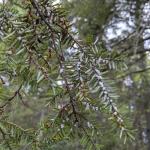 Hemlock Woolly Adelgid: Adelges tsugae (HWA) is present on eastern and Carolina hemlock. The overwintering hemlock woolly adelgid generation (sistens) is present through mid-spring and produces the spring generation (progrediens) which will be present from early spring through mid-summer. HWA, unlike many other insects, does most of its feeding over the winter. Eggs may be found in wooly masses at the base of hemlock needles beginning in mid-March. Each wooly mass is created by a female who may then lay 50-300 eggs. Hemlock woolly adelgid eggs were observed in samples collected in Amherst, MA on April 13, 2022. Eggs hatch and crawlers may be found from mid-March through mid-July.
Hemlock Woolly Adelgid: Adelges tsugae (HWA) is present on eastern and Carolina hemlock. The overwintering hemlock woolly adelgid generation (sistens) is present through mid-spring and produces the spring generation (progrediens) which will be present from early spring through mid-summer. HWA, unlike many other insects, does most of its feeding over the winter. Eggs may be found in wooly masses at the base of hemlock needles beginning in mid-March. Each wooly mass is created by a female who may then lay 50-300 eggs. Hemlock woolly adelgid eggs were observed in samples collected in Amherst, MA on April 13, 2022. Eggs hatch and crawlers may be found from mid-March through mid-July.
Nicole Keleher, Massachusetts Department of Conservation and Recreation (DCR) and the Director of their Forest Health Program, reports some curious observations about the hemlock woolly adelgid population in Massachusetts this year. Out of 17 sites across the state that they monitored for HWA winter mortality, they averaged approximately 47% mortality of the adelgid over the winter. This is relatively low, in the context of recent year’s winter mortality. The 17 sites had adelgid winter mortality that ranged from 23% to 80% of the insects sampled, but most sites were in the 40-50% range – providing us with the 47% average. Given those percentages, and the fact that these insects reproduce parthenogenetically (females lay viable eggs without mating), MA DCR notes that they are seeing lower than expected densities of HWA right now. Anecdotally, they suspect this may be because of mortality in the spring progrediens generation, rather than the more typical winter mortality of the sistens generation. What is the reason for this? We are uncertain. Anecdotally, it also seems that hemlock woolly adelgid populations in western MA may be higher this season than those in eastern MA. Again, the reasons for these observations are currently unknown, and this information should be considered mostly anecdotal at this time.
What does all of this mean for hemlock woolly adelgid management this season? I am not sure. Perhaps trees in eastern MA may experience a bit of a reprieve from this insect in 2022, whereas those in western MA may not. However, as DCR notes there is site variability with their observations – so this information cannot be applied for every scenario. The important thing is to monitor specimen hemlock trees and shrubs in managed landscapes and make management decisions based on site-specific observations and historical recordkeeping at each individual location.
-
Spongy Moth: Lymantria dispar egg masses will soon be hatching, roughly between 90 -100 growing degree days (roughly the first week in May, but this varies annually, such as what we are experiencing with the cool start to spring in much of Massachusetts currently, ). They may be found, after overwintering, on just about any flat surface, including host plants such as oak, but also fencing, buildings, steps, outdoor furniture, and more. Scout properties, particularly in areas of Berkshire County, MA that experienced elevated L. dispar populations in 2021. If large numbers of egg masses are seen, monitor them now and in the coming weeks to better time egg hatch and caterpillar emergence. If egg masses are plentiful near high-value specimen trees in Berkshire County this year, consider applying the reduced risk insecticide Bacillus thuringiensis Kurstaki (Btk) to host plant leaves once caterpillars begin to feed, but before caterpillars are over ¾ inch in length.
Why did the common name for Lymantria dispar change recently? More information is available here: https://entsoc.org/news/press-releases/spongy-moth-approved-new-common-name-lymantria-dispar .
-
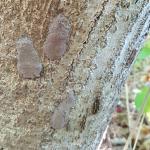 Spotted Lanternfly: (Lycorma delicatula, SLF) is a non-native, invasive insect that feeds on over 103 species of plants, including many trees and shrubs that are important in our landscapes. It overwinters as an egg mass, which the adult female insect lays on just about any flat surface. Pictures of egg masses can be seen here: https://massnrc.org/pests/linkeddocuments/SLFChecklistForResidents.pdf .
Spotted Lanternfly: (Lycorma delicatula, SLF) is a non-native, invasive insect that feeds on over 103 species of plants, including many trees and shrubs that are important in our landscapes. It overwinters as an egg mass, which the adult female insect lays on just about any flat surface. Pictures of egg masses can be seen here: https://massnrc.org/pests/linkeddocuments/SLFChecklistForResidents.pdf .
The MA Department of Agricultural Resources (MDAR) recently released the following “Notice to Nursery and Landscape Industry” regarding spotted lanternfly, an excerpt of which is included here:
Last year, the Massachusetts Department of Agricultural Resources (“MDAR”) detected populations of the invasive pest known as spotted lanternfly (Lycorma delicatula) in multiple locations throughout the state. Since this is the time of year that nurseries are receiving shipments of stock for the spring planting season, we are sending this notice to remind growers and landscapers to inspect any plant material coming from states where SLF has been found, to ensure it does not harbor SLF egg masses, and to report any finds to MDAR. This reminder is especially important as MDAR has recently received several reports that nursery stock from SLF-infested areas was sent to Massachusetts growers.
To read the FULL NOTICE, visit: https://massnrc.org/pests/blog/?p=2933 .
Currently, the only established populations of spotted lanternfly in Massachusetts are in a small area in both Fitchburg and Shrewsbury, MA. Therefore, there is no reason to be preemptively treating for this insect in other areas of Massachusetts. If you suspect you have found spotted lanternfly in additional locations, please report it immediately to MDAR here: https://massnrc.org/pests/slfreport.aspx . If you are living and working in the Fitchburg and Shrewsbury areas, please be vigilant and continue to report anything suspicious.
For More Information:
From UMass Extension:
Check out the InsectXaminer Episode about spotted lanternfly adults and egg masses! Available here: https://ag.umass.edu/landscape/education-events/insectxaminer
Fact Sheet: https://ag.umass.edu/landscape/fact-sheets/spotted-lanternfly
From the MA Department of Agricultural Resources:
Fact Sheet and Map of Locations in MA: https://massnrc.org/pests/pestFAQsheets/spottedlanternfly.html
-
Asian Longhorned Beetle: (Anoplophora glabripennis, ALB) Look for signs of an ALB infestation which include perfectly round exit holes (about the size of a dime), shallow oval or round scars in the bark where a female has chewed an egg site, or sawdust-like frass (excrement) on the ground nearby host trees or caught in between branches. Be advised that other, native insects may create perfectly round exit holes or sawdust-like frass, which can be confused with signs of ALB activity.
The regulated area for Asian longhorned beetle is 110 square miles encompassing Worcester, Shrewsbury, Boylston, West Boylston, and parts of Holden and Auburn. If you believe you have seen damage caused by this insect, such as exit holes or egg sites, on susceptible host trees like maple, please call the Asian Longhorned Beetle Eradication Program office in Worcester, MA at 508-852-8090 or toll free at 1-866-702-9938.
To report an Asian longhorned beetle find online or compare it to common insect look-alikes, visit: http://massnrc.org/pests/albreport.aspx or https://www.aphis.usda.gov/pests-diseases/alb/report .
-
Browntail Moth: Euproctis chrysorrhoea is an invasive insect originating from Europe and first detected in the US in Somerville, MA in 1897. Currently, browntail moth is limited to a small portion of eastern Massachusetts, particularly areas near the coast. Report suspected browntail moth life stages here: https://massnrc.org/pests/pestreports.htm . Due to a persistent outbreak of this insect in Maine since approximately 2016, it is a good idea for us to again familiarize ourselves with this pest. (For more information and the latest updates about the status of this insect in Maine, visit: https://www.maine.gov/dacf/mfs/forest_health/invasive_threats/browntail_moth_info.htm .)
Caution: hairs found on the caterpillar and pupal life stages of this insect can cause a rash similar to poison ivy. Some individuals are very sensitive to browntail moth hairs and may also experience allergic reaction. The chance of interacting with browntail moth hairs increases between May and July, although they could be a problem at any time of year.
The larval or caterpillar stage of this insect is present from August until the following June (spending the winter in webs they create on the tips of host plant twigs). In the fall, groups of caterpillars are found creating webs around a tightly wrapped leaf (covered in bright white silk) where they will overwinter in groups of 25-400. These 2-4 inch long webs can be found on the ends of branches often on apple or red oak. As soon as leaves begin to open in the spring (usually by April), the caterpillars will crawl from their webs to feed on the new leaves. Caterpillars are fully grown around June and spin cocoons in which they pupate. These cocoons are also full of the irritating hairs and should be dealt with extreme caution. Adult moths emerge in July and females lay eggs on the undersides of leaves in masses of 200-400, covering them with hairs from their bodies. (Adults do not typically cause skin rashes.) Eggs hatch around August and September and larvae feed shortly before forming their overwintering webs.
The primary concern with this insect are the poisonous hairs found on the caterpillars. Contact with the caterpillar or its hairs can cause a rash similar to poison ivy in susceptible individuals. If hairs break off and blow around in the wind, they can cause difficulty breathing and headaches. While this insect can act as a defoliator in the larval stage, feeding on the leaves of many deciduous trees and shrubs, this activity may be secondary to concerns about public health risks. Care should be taken to avoid places infested with these caterpillars, exposed skin or clothing should be washed, and the appropriate PPE should be worn if working with these insects. Consult your physician if you have a reaction to the browntail moth.
-
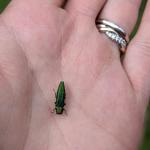 Emerald Ash Borer: (Agrilus planipennis, EAB) has been detected in at least 11 out of the 14 counties in Massachusetts. A map of these locations across the state may be found here: https://ag.umass.edu/fact-sheets/emerald-ash-borer . Additional information about this insect is provided by the MA Department of Conservation and Recreation, here: https://storymaps.arcgis.com/stories/b60f63199fa14805a8b9f7c82447a25b .
Emerald Ash Borer: (Agrilus planipennis, EAB) has been detected in at least 11 out of the 14 counties in Massachusetts. A map of these locations across the state may be found here: https://ag.umass.edu/fact-sheets/emerald-ash-borer . Additional information about this insect is provided by the MA Department of Conservation and Recreation, here: https://storymaps.arcgis.com/stories/b60f63199fa14805a8b9f7c82447a25b .
This wood-boring beetle readily attacks ash (Fraxinus spp.) including white, green, and black ash and has also been found developing in white fringe tree (Chionanthus virginicus) and has been reported in cultivated olive (Olea europaea). Signs of an EAB infested tree may include D-shaped exit holes in the bark (from adult emergence), “blonding” or lighter coloration of the ash bark from woodpecker feeding (chipping away of the bark as they search for larvae beneath), and serpentine galleries visible through splits in the bark, from larval feeding beneath. It is interesting to note that woodpeckers are capable of eating 30-95% of the emerald ash borer larvae found in a single tree (Murphy et al. 2018). Unfortunately, despite high predation rates, EAB populations continue to grow. However, there is hope that biological control efforts will eventually catch up with the emerald ash borer population and preserve some of our native ash tree species for the future. For an update about the progress of the biological control of emerald ash borer, visit Dr. Joseph Elkinton’s archived 2022 webinar now available here: https://ag.umass.edu/landscape/education-events/invasive-insect-webinars .
-
Winter Moth: (Operophtera brumata) data since 2017 has indicated that the winter moth population in eastern Massachusetts has been on the decline while the percent of winter moth pupae parasitized by Cyzenis albicans has increased! Dr. Joseph Elkinton’s laboratory at UMass Amherst has released this biological control of winter moth since 2005 and conducted the rigorous sampling required to determine where the insect has established and what its impact on the winter moth population has been at multiple sites in eastern MA. More information about the Elkinton Lab’s research and the biological control of winter moth can be found here: https://www.fs.fed.us/foresthealth/technology/pdfs/FHAAST-2018-03_Biology_Control_Winter-Moth.pdf .
The take-home point? Do not worry about winter moth this spring! In fact, management of this insect in landscaped settings will likely not be necessary in most locations. Blueberry and apple growers may still, on the other hand, be interested in scouting and continuing to monitor for this insect, as only very low numbers of winter moth caterpillars might be tolerated in those systems. For an April 16, 2022 update about winter moth in blueberry and apple production from Heather Faubert, University of Rhode Island, visit: https://web.uri.edu/ipm/2022/04/2667/ .
In recent years, it is worthwhile to note that some areas on the Cape and other locations in eastern MA have reported noticeable cankerworm populations in the spring, which are often confused for winter moth. Read more about cankerworms in the spring scouting list below.
-
Jumping Worms: Amynthas spp. earthworms, collectively referred to as “jumping or crazy or snake” worms, overwinter as eggs in tiny, mustard-seed sized cocoons found in the soil or other substrate (ex. compost). The tiny, impossible to remove cocoons will overwinter and provide a population of these earthworms in the 2022 season.
For More Information:
UMass Extension Fact Sheets:
Earthworms in Massachusetts – History, Concerns, and Benefits: https://ag.umass.edu/landscape/fact-sheets/earthworms-in-massachusetts-history-concerns-benefits
Jumping/Crazy/Snake Worms – Amynthas spp.:
https://ag.umass.edu/landscape/fact-sheets/jumpingcrazysnake-worms-amynthas-spp
A Summary of the Information Shared at UMass Extension’s Jumping Worm Conference in January 2022:
https://ag.umass.edu/news-events/highlights/jumping-worms-conference
Tree & Shrub Insect Pests, Continued:
-
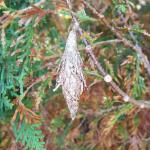 Bagworm: Thyridopteryx ephemeraeformis is a native species of moth whose larvae construct bag-like coverings over themselves with host plant leaves and twigs. This insect overwinters in the egg stage, within the bags of deceased females from last season. Eggs may hatch and young larvae are observed feeding around mid-June, or roughly between 600-900 GDD’s. Now is the time to scout for and remove and destroy overwintering bags. More information can be found here: https://ag.umass.edu/landscape/fact-sheets/bagworm
Bagworm: Thyridopteryx ephemeraeformis is a native species of moth whose larvae construct bag-like coverings over themselves with host plant leaves and twigs. This insect overwinters in the egg stage, within the bags of deceased females from last season. Eggs may hatch and young larvae are observed feeding around mid-June, or roughly between 600-900 GDD’s. Now is the time to scout for and remove and destroy overwintering bags. More information can be found here: https://ag.umass.edu/landscape/fact-sheets/bagworm -
Balsam Twig Aphid: Mindarus abietinus overwinters as a silvery colored egg on host plant twigs. Eggs hatch just prior to budbreak and nymphs feed for a period of time on the undersides of last season’s needles before molting into a wingless stem mother. Stem mothers move to buds just as they open and give “live birth” to second generation nymphs. These second generation nymphs are the most damaging, feeding on new needles as they elongate, causing distortion and stunting. Excessive amounts of honeydew may be produced and cause needles to stick together. Foliar applications, if needed, may be made between 30-100 GDD’s, base 50°F on warm days before budcaps loosen. Inspect the twigs, near the base of needles of Balsam fir, Fraser fir, and other true firs for overwintering eggs and eventually the needles for feeding nymphs. This insect may be most problematic in Christmas tree production. In landscapes, many natural enemies can provide adequate management of this insect.
-
Black Turpentine Beetle: Dendroctonus terebrans adults may begin to be active between mid-April to mid-May. Host plants include: black pine (Pinus thunbergiana), eastern white pine (Pinus strobus), Japanese black pine (Pinus thunbergii), loblolly pine (Pinus taeda), pitch pine (Pinus rigida), red spruce (Picea rubens), Scots pine (Pinus sylvestris), and slash pine (Pinus elliottii).
This is one of the largest native North American bark beetles. In the northern parts of its extensive range, the black turpentine beetle overwinters as an adult in the bark of its hosts. In the southern portions of its range, all life stages may be present throughout the year. Egg laying and feeding is usually kept to the basal 6 feet of the host plant. Mated pairs of adult beetles work to excavate galleries that may be 9.8 inches wide and 11.8 inches long. 100-200 eggs may be laid on one side of the gallery. Once hatched, larvae feed in groups on the inner bark. Fully grown larvae are legless, white, and almost 1/2 inch in length. Pupation occurs and adults eventually emerge from the bark to re-infest the same tree, or disperse to another susceptible host.
Stumps and buttress roots of freshly cut trees are favored by this insect. Attacked trees may exhibit browning of needles and oozing of large masses of pitch. Masses of pitch (pitch tubes) may cover holes in the trunk and may be considerably larger than those of southern pine beetle. Pitch hardens and is first white but may turn red as it ages. Pitch is irregular in shape and up to 1.6 inches in diameter. Pitch tubes are not visible when the area below the soil line is attacked. Healthy trees are usually not attacked, however it has been reported on occasion.
Check drought-stressed or otherwise stressed trees for needles turning light green to rust color. Check the lower 6 feet, particularly the lower 18 inches of the trunk for 1.6 inch in diameter pitch tubes or small entrance holes from the adults. Reddish-brown boring dust may be found near the base of the tree as well.
-
Boxwood Leafminer: Monarthropalpus flavus partly grown fly larvae overwinter in the leaves of susceptible boxwood. Yellowish mines may be noticeable on the undersides of leaves. This insect grows rapidly in the spring, transforming into an orange-colored pupa. After pupation, adults will emerge and white colored pupal cases may hang down from the underside of leaves where adults have emerged. Adults may be observed swarming hosts between 300-650 GDD’s, or roughly the end of May through June. Most cultivars of Buxus sempervirens and B. microphylla are thought to be susceptible. If installing new boxwoods this spring, resistant cultivars such as ‘Vardar Valley’ and ‘Handsworthiensis’ are good choices at sites where this insect has been a problem.
-
Boxwood Mite: Eurytetranychus buxi overwinter as tiny eggs on boxwood leaves and hatch mid-spring. These mites are tiny (about the size of a period) and difficult to detect. Feeding may cause plants to appear off-color. If management is deemed necessary, the timing for treatment may be between 245-600 GDD’s.
-
Boxwood Psyllid: Psylla buxi feeding can cause cupping of susceptible boxwood leaves. Leaf symptoms/damage may remain on plants for up to two years. English boxwood may be less severely impacted by this pest. Eggs overwinter, buried in budscales, and hatch around budbreak of boxwood. Eggs may hatch around 80 GDD’s. While foliar applications may be made between 290-440 GDD’s, the damage caused by this insect is mostly aesthetic. Therefore, typically, management is not necessary.
-
Cankerworms: Alsophila pometaria (fall cankerworm) and Paleacrita vernata (spring cankerworm) are often confused for winter moth (Operophtera brumata). Cankerworm populations in eastern MA, particularly on areas of Cape Cod, were confused for winter moth in 2019. Spring cankerworm adults are active in February and March, and fall cankerworm adults are active in late November into early December. During these times, both species lay eggs. These native insects most commonly utilize elm, apple, oak, linden, and beech. Eggs of both species hatch as soon as buds begin to open in the spring. Caterpillars occur in mixed populations and are often noticeable by mid-May in MA. Young larvae will feed on buds and unfolding leaves. There are two color forms (light green and dark) for caterpillars of both species. Like winter moth, they will drop to the soil to pupate. This usually occurs in June. Fall cankerworm larvae have three pairs of prolegs (one of which is small so it is sometimes referred to as ½) and spring cankerworm have two pairs. (Winter moth caterpillars also have 2 pairs of prolegs.) If populations are large and damage is noticeable on hosts, reduced risk insecticides such as Bacillus thuringiensis Kurstaki or spinosad may target larvae between approximately 148-290 GDD’s.
-
Cooley Spruce Gall Adelgid: Adelges cooleyi is a native insect that has a complex life cycle. It has at least five different morphological forms, and requires 2 years and two hosts to complete its normal life cycle. Galls (pineapple shaped/cone-like and at the tips of twigs) are produced on Colorado blue spruce, Engelmann, Sitka, and Oriental spruce and cause needle injury (yellow spots and distortion) to Douglas-fir. Immature females overwinter on spruce near twig terminals. In the early spring, females mature into stem mothers and lay hundreds of eggs on lateral terminals. Upon egg hatch, nymphs migrate to new spring growth and feed at the base of growing needles. Immatures can be targeted on spruce between 22-81 GDD’s. On Douglas-fir, dormant oil applications should be made immediately before budbreak to avoid phytotoxicity. Follow all label instructions.
-
Dogwood Borer: Synanthedon scitula is a species of clearwing moth whose larvae bore not only into dogwood (Cornus), but hosts also include flowering cherry, chestnut, apple, mountain ash, hickory, pecan, willow, birch, bayberry, oak, hazel, myrtle, and others. Kousa dogwood appear to be resistant to this species. Signs include the sloughing of loose bark, brown frass, particularly near bark cracks and wounds, dead branches, and adventitious growth. The timing of adult emergence can be expected when dogwood flower petals are dropping and weigela begins to bloom. Adult moth flights continue from then until September. Emergence in some hosts (ex. apple) appears to be delayed, but this differs depending upon the location in this insect’s range. Eggs are laid singly, or in small groups, on smooth and rough bark. Female moths preferentially lay eggs near wounded bark. After hatch, larvae wander until they find a suitable entrance point into the bark. This includes wounds, scars, or branch crotches. This insect may also be found in twig galls caused by other insects or fungi. Larvae feed on phloem and cambium. Fully grown larvae are white with a light brown head and are approx. ½ inch long. Pheromone traps and lures are useful for determining the timing of adult moth emergence and subsequent management.
-
Dogwood Sawfly: Macremphytus tarsatus has one generation per year. The larvae of the dogwood sawfly overwinter in decaying wood and occasionally compromised structural timber. An overwintering "cell" is created in this soft wood. Pupation occurs in the springtime and adults can take a lengthy time to emerge, roughly between late May and July. 100+ eggs are laid in groups on the underside of leaves. Eggs hatch and the larvae feed gregariously, initially skeletonizing leaves. As the caterpillars grow in size, they are capable of eating the entire leaf with the exception of the midvein. Larval appearance varies greatly throughout instars, so much so that one might mistake them for multiple species. Early instars are translucent and yellow, but as the caterpillars grow they develop black spots (over yellow) and become covered in a white powder-like material. Larvae and their shed skins may resemble bird droppings. Full grown larvae begin to wander in search of a suitable overwintering location. Rotting wood lying on the ground is preferred for this. Foliage of dogwood, especially gray dogwood (Cornus racemosa) may be impacted. Skeletonizes leaves at first, then eats all but the midvein.
-
Eastern Spruce Gall Adelgid: Adelges abietis is a pest of Norway spruce primarily, but occasionally damages other spruce species such as Colorado blue, white, and red spruce. This adelgid overwinters as a partially grown female, often referred to as a stem mother. This overwintering individual matures around bud break and lays 100-200 eggs. The eastern spruce gall adelgid may be targeted for management between 22-170 GDD’s, base 50°F (mid-April to early-May). This insect is non-native, and was introduced into the United States from Europe before 1900. Galls are small, sometimes pineapple shaped/variable, but produced on the basal portion of the shoots, such that the twig extends beyond the gall. Twig dieback may occur.
-
Eastern Tent Caterpillar: Malacosoma americanum eggs overwinter on host plant twigs. Egg hatch typically occurs when wild cherry leaves begin to unfold and young caterpillars may emerge by late-April through the first two weeks in May (90-190 GDD’s). Susceptible hosts include cherry and crabapple. Other host plants whose leaves are fed upon by this native insect can include apple, ash, birch, willow, maple, oak, poplar, and witch-hazel. Prune off and remove egg masses from ornamental host plants by early spring. Eastern tent caterpillars are native to Massachusetts and have many associated natural enemies (parasites and predators) that help regulate populations. Unless these caterpillars are actively defoliating specimen trees in a landscaped setting, we can coexist with this particular herbivore native to our forests.
-
Elm Leaf Beetle: Xanthogaleruca (formerly Pyrrhalta) luteola is found on American elm (Ulmus americana; not preferred), Chinese Elm (Ulmus parvifolia; not preferred), English Elm (Ulmus procera; preferred host), Japanese Zelkova (Zelkova serrata), and Siberian Elm (Ulmus pumila; preferred host).
This species was accidentally introduced into the eastern United States early in the 1800's. Since then, it has been found throughout the USA anywhere elms are located. It also occurs in eastern Canada. The adult elm leaf beetle overwinters in protected areas, such as the loose bark of trees, but can also be a nuisance when it tries to invade homes in search of overwintering protection. Beetles will try to enter houses or sheds in the fall.
In the spring, the adult beetles will fly back to the host plant and chew small, semi-circular holes in the leaves. The adult female can lay 600-800 yellow eggs in her life. Eggs are laid in clusters on the leaves and resemble pointy footballs. Larvae are tiny, black, and grub-like when they hatch from the egg. Young larvae will skeletonize the undersides of leaves. As they grow in size, the larvae become yellow-green with rows of black projections. Oldest larvae may appear to have two black stripes along their sides, made from the black projections. There are 3 larval instars. Mature larvae will wander down the trunk of the host tree and pupate in the open on the ground at the tree base or in cracks and crevices in the trunk or larger limbs. They spend approximately 10 or so days as a pupa, and then the adults emerge. Those adults will fly to the foliage of the same host plant or other adjacent potential hosts in the area, where they will lay eggs. In the fall, the adults will leave the host plant in search of overwintering shelter. In most locations in the USA, two generations of this insect are possible per year. In warmer locations, 3-4 generations per year are possible.
Leaves are skeletonized by the larvae. Skeletonization may cause the leaf to turn brown or whitish. Adults are capable of chewing through the leaf, often in a shothole pattern. When in very large populations, they are capable of completely defoliating plants. Populations of this insect can fluctuate from year to year, and often management is not necessary if populations are low. However, defoliation for consecutive seasons may lead to branch dieback or death of the entire tree.
-
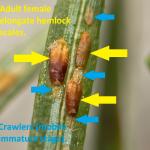 Elongate Hemlock Scale: Fiorinia externa is found on eastern, Carolina, and Japanese hemlock, as well as yew, spruce, and fir. The elongate hemlock scale may overwinter in various life stages and overlap of many developmental stages at any given time can be observed throughout much of the season. Dormant oil applications for this pest can occur according to label instructions in April, roughly between 7-120 GDD’s. Treatments for the crawler, or mobile, stage of this insect may be made in late May through mid-June, or between 360-700 GDD’s, base 50°F. Nitrogen fertilizer applications may make elongate hemlock scale infestations worse.
Elongate Hemlock Scale: Fiorinia externa is found on eastern, Carolina, and Japanese hemlock, as well as yew, spruce, and fir. The elongate hemlock scale may overwinter in various life stages and overlap of many developmental stages at any given time can be observed throughout much of the season. Dormant oil applications for this pest can occur according to label instructions in April, roughly between 7-120 GDD’s. Treatments for the crawler, or mobile, stage of this insect may be made in late May through mid-June, or between 360-700 GDD’s, base 50°F. Nitrogen fertilizer applications may make elongate hemlock scale infestations worse. -
Euonymus Scale: Unaspis euonymi is an armored scale that can be found on euonymus, holly, bittersweet, and pachysandra. This insect can cause yellow spotting on leaves, dieback, and distorted bark. Dormant oil applications can be made between 35-120 GDD’s or roughly from mid-April to early-May. For crawlers, early June timing is suggested between 533-820 GDD’s. (Eggs begin to hatch in early June.)
-
European Pine Sawfly: Neodiprion sertifer overwinters in the egg stage. Eggs are laid by females the previous season by cutting slits in needles using their ovipositors and depositing 6-8 eggs in each of 10-12 needles. Egg hatch occurs from late-April to mid-May and caterpillars become active roughly between 78-220 GDD, base 50°F. The primary host in MA is Mugo pine but it can be found on Scots, red, jack, and Japanese red pine. It is also found on white, Austrian, ponderosa, shortleaf, and pitch pine when planted near the aforementioned species. This dark colored caterpillar feeds in tight groups and small numbers can be pruned or plucked out of host plants and destroyed. Spinosad products can be used whenever the caterpillars are actively feeding, usually by mid-May and when caterpillars are still small. Bacillus thuringiensis kurstaki is not effective against sawflies.
-
Fletcher Scale: Parthenolecanium fletcheri is a soft scale pest of yew, juniper, and arborvitae. Feeding scales, especially on yew, result in honeydew and sooty mold, needle yellowing, and at times, premature needle drop. There is one generation per year. Overwintered second instar nymphs can be targeted between 38-148 GDD’s, base 50°F. Nymphs develop and adult females lay eggs (on average 500-600) in May that hatch by June. Dead females conceal egg masses beneath. Crawlers migrate short distances to branches and may be concentrated on certain branches of a particular plant.
-
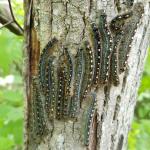 Forest Tent Caterpillar: Malacosoma disstria egg hatch occurs between 192-363 GDD’s, base 50°F, by mid-late May and caterpillars may be active for at least 5-6 weeks following. Susceptible hosts whose leaves are fed on by this insect include oak, birch, ash, maple, elm, poplar, and basswood. This native insect has many natural enemies, including some very effective pathogens that typically regulate populations. However, outbreaks of this insect can occur on occasion.
Forest Tent Caterpillar: Malacosoma disstria egg hatch occurs between 192-363 GDD’s, base 50°F, by mid-late May and caterpillars may be active for at least 5-6 weeks following. Susceptible hosts whose leaves are fed on by this insect include oak, birch, ash, maple, elm, poplar, and basswood. This native insect has many natural enemies, including some very effective pathogens that typically regulate populations. However, outbreaks of this insect can occur on occasion. -
Hemlock Looper: Two species of geometrid moths in the genus Lambdina are native insects capable of defoliating eastern hemlock, balsam fir, and white spruce. Adult moths lay their eggs on the trunk and limbs of hosts in September and October, and eggs will hatch by late May or early June. (L. fiscellaria caterpillars may be active between 448-707 GDD’s.) Monitor susceptible hosts for small, inch-worm like caterpillars. Where populations are low, no management is necessary. Hemlock loopers have several effective natural enemies.
 Imported Willow Leaf Beetle: Plagiodera versicolora adult beetles overwinter near susceptible hosts. Adult beetles will chew holes and notches in the leaves of willow once they become available. Females lay yellow eggs in clusters on the undersides of leaves. Larvae are slug-like and bluish-green in color. They will feed in clusters and skeletonize the leaves. Most plants can tolerate multiple years of feeding from this insect, and foliage will appear brown. Repeated yearly feeding can occasionally be an issue, in which case management of the young larvae may be necessary. Take care with treatment in areas near water.
Imported Willow Leaf Beetle: Plagiodera versicolora adult beetles overwinter near susceptible hosts. Adult beetles will chew holes and notches in the leaves of willow once they become available. Females lay yellow eggs in clusters on the undersides of leaves. Larvae are slug-like and bluish-green in color. They will feed in clusters and skeletonize the leaves. Most plants can tolerate multiple years of feeding from this insect, and foliage will appear brown. Repeated yearly feeding can occasionally be an issue, in which case management of the young larvae may be necessary. Take care with treatment in areas near water.
Check out Episode 4 of InsectXaminer to see the imported willow leaf beetle in action: https://ag.umass.edu/landscape/education-events/insectxaminer
-
Honeylocust Plant Bug: Diaphnocoris chlorionis feeding results in tiny yellowish-brownish spots on leaves, leaf distortion, and in some cases, defoliation. (There are at least 7 species of plant bugs that feed on honeylocust, Gleditsia triacanthos.) There is one generation per year. Immatures and adults feed on foliage and light to moderately damaged foliage may persist throughout the growing season. Honeylocust plant bugs overwinter as eggs laid just beneath the bark surface of 2- and 3-year-old twigs. Eggs hatch just after vegetative buds of the host begin to open. Young nymphs crawl to the opening leaflets and begin feeding and the most significant damage occurs at that time, when the insect is hidden from view. Nymphs develop into adults around May-July. This insect can be targeted between 58-246 GDD’s, base 50°F.
-
Lilac Borer: Podosesia syringae is a clearwing moth pest of lilac, privet, fringetree, and ash. (It is also known as the ash borer, not to be confused with the emerald ash borer.) Adults mimic paper wasps. Larvae are wood-boring, and signs and symptoms include branch dieback, holes, and occasionally, sawdust-like frass accumulated on bark. Larvae bore into stems, trunks, and branches, chewing an irregularly shaped entrance hole. Peak adult moth flights may occur in the northern portion of this insect’s range in June and are usually over by August 1st. Pheromone traps can be used to time adult emergence. Adult females lay flattened, oval, and tan eggs that are deposited singly or in clusters on bark crevices, ridges, and sometimes smooth bark; but usually laid in or near wounds in the bark. On average, 395 eggs are laid by each female. After hatch, larvae chew into the bark and feed laterally and then vertically in phloem tissue. Larvae overwinter in tunnels in the final instar and resume feeding in the spring. Adults emerge through a round exit hole (4-5 mm. in diameter). This insect may be targeted between 200-299 GDD’s, base 50°F.
-
Lecanium Scales (Oak): Parthenolecanium quercifex overwinters as a second instar nymph on oak twigs. Females will begin feeding and mature in the spring, from mid-April to early May and eggs may be laid between late May and into June. Eggs hatch in June or early July and crawlers migrate to host plant leaves where they spend the summer and migrate as second instars back to host plant twigs in the fall. Mid-April to early-May (35-145 GDD’s) for dormant oil applications.
-
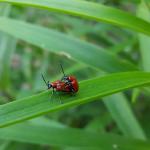 Lily Leaf Beetle: Lilioceris lilii adults overwinter in sheltered places. As soon as susceptible hosts such as Lilium spp. (Turk’s cap, tiger, Easter, Asiatic, and Oriental lilies) and Fritillaria spp. break through the ground, the adult lily leaf beetles are known to feed on the new foliage. (Note: daylilies are not hosts.) Typically, in May, mating will occur and each female will begin to lay 250-450 eggs in neat rows on the underside of the foliage. If there are only a few plants in the garden, hand picking and destroying overwintering adults can help reduce local garden-level populations at that time.
Lily Leaf Beetle: Lilioceris lilii adults overwinter in sheltered places. As soon as susceptible hosts such as Lilium spp. (Turk’s cap, tiger, Easter, Asiatic, and Oriental lilies) and Fritillaria spp. break through the ground, the adult lily leaf beetles are known to feed on the new foliage. (Note: daylilies are not hosts.) Typically, in May, mating will occur and each female will begin to lay 250-450 eggs in neat rows on the underside of the foliage. If there are only a few plants in the garden, hand picking and destroying overwintering adults can help reduce local garden-level populations at that time.
Check out Episode 3 of InsectXaminer to see the lily leaf beetle in action: https://ag.umass.edu/landscape/education-events/insectxaminer
-
Magnolia Scale: Neolecanium cornuparvum overwinters as first instar nymphs which are elliptical, and dark slate gray in color and can usually be found on the undersides of 1 and 2 year old twigs. Nymphs may molt by late April or May and again by early June at which time the scales may be purple in color. Eventually nymphs secrete a white powdery layer of wax over their bodies.
-
Snowball Aphid: Neoceruraphis viburnicola eggs overwinter on viburnum twigs and buds. Eggs hatch and this aphid becomes active on certain species of viburnum roughly between 148-298 GDD’s or around redbud bloom. This insect is particularly noticeable on V. opulus, V. prunifolium, and V. acerifolia. Stem mothers, appearing blueish-white, can be found in curled up and distorted foliage. Damage caused by this insect pest is mostly aesthetic.
-
Spruce Bud Scale: Physokermes piceae is a pest of Alberta and Norway spruce, among others. Immatures overwinter on the undersides of spruce needles, dormant until late March. By April, females may move to twigs to complete the rest of their development. Dormant oil applications may be made between 22-121 GDDs. Follow all label instructions, as oil may remove the bluish color from certain conifers. Mature scales are reddish brown, globular, 3 mm. in diameter, and found in clusters of 3-8 at the base of new twig growth. They closely resemble buds and are often overlooked. Crawlers are present around June.
-
Spruce Spider Mite: Oligonychus ununguis is a cool-season mite that becomes active in the spring from tiny eggs that have overwintered on host plants. Hosts include spruce, arborvitae, juniper, hemlock, pine, Douglas-fir, and occasionally other conifers. This particular species becomes active in the spring and can feed, develop, and reproduce through roughly June. When hot, dry summer conditions begin, this spider mite will enter a summer-time dormant period (aestivation) until cooler temperatures return in the fall. This particular mite may prefer older needles to newer ones for food. Magnification is required to view spruce spider mite eggs. Tapping host plant branches over white paper may be a useful tool when scouting for spider mite presence. (View with a hand lens.) Spider mite damage may appear on host plant needles as yellow stippling and occasionally fine silk webbing is visible. Be sure to also scout for predatory mite adults and eggs which can help regulate spruce spider mite populations. Avoid broad spectrum chemical management options that kill predatory mite populations, often making spruce spider mite outbreaks worse.
-
Viburnum Leaf Beetle: Pyrrhalta viburni is a beetle in the family Chrysomelidae that is native to Europe, but was found in Massachusetts in 2004. Viburnum leaf beetle overwinters as eggs laid in capped pits on the newest growth of susceptible viburnum branches. Scout for overwintered eggs and prune out and destroy before they hatch. Egg hatch occurs in late-April to early-May as temperatures warm and foliage becomes available. Monitor for larvae in mid-May (80-120 GDD’s). This beetle feeds exclusively on many different species of viburnum, which includes, but is not limited to, susceptible plants such as V. dentatum, V. nudum, V. opulus, V. propinquum, and V. rafinesquianum. Some viburnum have been observed to have varying levels of resistance to this insect, including but not limited to V. bodnantense, V. carlesii, V. davidii, V. plicatum, V. rhytidophyllum, V. setigerum, and V. sieboldii. More information about viburnum leaf beetle may be found at http://www.hort.cornell.edu/vlb/ .
-
White Spotted Pine Sawyer (WSPS): Monochamus scutellatus adults can emerge in late May throughout July, depending on local temperatures. This is a native insect in Massachusetts and is usually not a pest. Larvae develop in weakened or recently dead conifers, particularly eastern white pine (Pinus strobus). However, the white spotted pine sawyer looks very similar to the invasive Asian Longhorned Beetle, Anoplophora glabripennis, ALB. ALB adults do not emerge in Massachusetts until July and August. Beginning in July, look for the key difference between WSPS and ALB adults, which is a white spot in the top center of the wing covers (the scutellum) on the back of the beetle. White spotted pine sawyer will have this white spot, whereas Asian longhorned beetle will not. Both insects can have other white spots on the rest of their wing covers; however, the difference in the color of the scutellum is a key characteristic. See the Asian longhorned beetle entry above for more information about that non-native insect.
-
Woolly Apple Aphid: Eriosoma lanigerum may be found on apple, crabapple, hawthorn, mountain-ash, Pyracantha, and elm hosts. The primary (winter) host is elm, on which aphids infest emerging spring leaves, causing leaves to curl or close into stunted, rosette-like clusters found at twig tips. On apple and crabapple, this species of aphid colonizes roots, trunks, and branches in the summer and is commonly found near previous wounds or callous tissue. On roots, the aphids cause swelled areas which can girdle and kill roots. The aphids, when found in above ground plant parts such as elm leaves, are covered with white wax. Eggs are the overwintering stage on elm, which hatch in the spring in time for the nymphs to infest new elm foliage. Following a few generations on elm, the aphids will develop into a winged form, which will disperse and seek out apple and crabapple. Multiple generations will occur on these alternate hosts in the summer and by the fall, a winged form will return to elm and mated females will lay eggs near elm buds. These aphids are a favorite snack for insect predators such as the multicolored Asian lady beetle, Harmonia axyridis. Elm can withstand multiple years of woolly apple aphid infestation and this insect is primarily aesthetic in its impact to trees. Management may not be necessary.
-
Woolly Elm Aphid: Eriosoma americanum females lay a single egg in the cracks and crevices of elm bark, where the egg overwinters. Eggs hatch on elm in the spring as leaves are unfolding. Aphids may be active from 121-246 GDD’s, base 50°F on elm. A young, wingless female hatched from the egg feeds on the underside of leaf tissue. This female aphid matures and gives birth to 200 young, all females, without mating. These aphids feed, and the elm leaf curls around them and protects them. By the end of June, winged migrants mature and find serviceberry hosts. Another set of females is produced. These new females crawl to and begin feeding on the roots of serviceberry. Multiple generations occur on the roots of serviceberry through the summer. Elm can withstand multiple years of woolly elm aphid infestation and this insect is primarily aesthetic in its impact to trees. Management may not be necessary. Lady beetle larvae and adults often feed on these insects.
Concerned that you may have found an invasive insect or suspicious damage caused by one? Need to report a pest sighting? If so, please visit the Massachusetts Introduced Pests Outreach Project: http://massnrc.org/pests/pestreports.htm .
Reported by Tawny Simisky, Extension Entomologist, UMass Extension Landscape, Nursery, & Urban Forestry Program
Landscape Practices
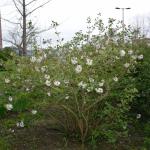
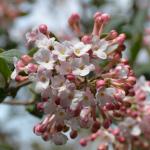 May is a great time to appreciate the Viburnum species. Viburnum x juddii is a hybrid viburnum introduced at the Arnold Arboretum. It is a cross between V. carlesii x V. bitchiuense. Considered one of the best semi-snowball forms by Michael Dirr, Juddi viburnum is a rounded shrub growing 6-8’ tall by 6-10’ wide. Inflorescence buds are pink maturing to white. Similar to its parents, Inflorescences are sweetly fragrant. Leaves are a dull green with a grayish underside with both sides being pubescent. Fall color can be variable but can be red to red-purple. Flowers give way to clusters of berry-like drupes that change from red to black in late summer to early fall. The look is similar to V. carlesii but, V. juddii is generally considered to be denser with more flowers and better heat tolerance in zones 7-8. Juddi viburnum has no serious insect or disease problems and has good resistance to bacterial leaf spot, powdery mildew, and viburnum leaf beetle. It grows best in a well-drained soil in full sun to part shade. Plants can be used as a specimen or in groups in the shrub border.
May is a great time to appreciate the Viburnum species. Viburnum x juddii is a hybrid viburnum introduced at the Arnold Arboretum. It is a cross between V. carlesii x V. bitchiuense. Considered one of the best semi-snowball forms by Michael Dirr, Juddi viburnum is a rounded shrub growing 6-8’ tall by 6-10’ wide. Inflorescence buds are pink maturing to white. Similar to its parents, Inflorescences are sweetly fragrant. Leaves are a dull green with a grayish underside with both sides being pubescent. Fall color can be variable but can be red to red-purple. Flowers give way to clusters of berry-like drupes that change from red to black in late summer to early fall. The look is similar to V. carlesii but, V. juddii is generally considered to be denser with more flowers and better heat tolerance in zones 7-8. Juddi viburnum has no serious insect or disease problems and has good resistance to bacterial leaf spot, powdery mildew, and viburnum leaf beetle. It grows best in a well-drained soil in full sun to part shade. Plants can be used as a specimen or in groups in the shrub border.
Report by Mandy Bayer, Extension Assistant Professor of Sustainable Landscape Horticulture, UMass Stockbridge School of Agriculture
A Lawn Care Message from the Pioneer Valley Planning Commission
Achieving beautiful, functional lawns is possible using practices consistent with local efforts in many communities to improve water quality in local rivers, streams, lakes, and coastal waters. Improper lawn care practices can contribute to storm flows that are especially high in nutrients. Negligent use and disposal of grass clippings and fertilizers can put nitrogen and phosphorous into storm runoff that enters local waters. These polluted flows promote the growth of algae and reduce dissolved oxygen, impacting recreational uses, such as swimming and fishing, and quality of habitat for wildlife.
Lean into the spring season with better lawn care practices. Here are two great strategies:
Leave grass clippings where they fall - Of course, you want to leave things nice and neat for your clients, but let them know that grass clippings left on the lawn will decompose, returning valuable nutrients back into the soil. This will save them money by reducing the need for applied fertilizer and promote a healthier lawn. To make best use of this free, natural fertilizer: mow high according to the grass species and use of the turf, do not remove more than 1/3 of the blade per mowing event, and mow when grass is dry.
Test your client's soil -A soil test lets you know specifically what your client's lawn and garden need for nutrients so that you don’t waste time and money. UMass Extension provides soil testing services. See: http://umass.edu/soiltest. Opt for slow release nitrogen sources if possible, and time applications properly to best align maximum nutrient availability from applied fertilizer with favorable growth periods, to promote maximum nutrient uptake and minimize potential loss.
Do your part and start better land care practices this spring. For more information see: https://thinkblueconnecticutriver.org/lawn-and-yard-care/ and https://ag.umass.edu/resources/home-lawn-garden/fact-sheets/lawns
From the municipalities collaborating on Think Blue Connecticut River and Think Blue Massachusetts.
Additional Resources
Pesticide License Exams - The MA Dept. of Agricultural Resources (MDAR) is now holding exams online. For more information and how to register, go to: https://www.mass.gov/pesticide-examination-and-licensing.
To receive immediate notification when the next Landscape Message update is posted, join our e-mail list or follow us on Facebook.
For a complete listing of upcoming events, see our upcoming educational events https://ag.umass.edu/landscape/upcoming-events
For commercial growers of greenhouse crops and flowers - Check out UMass Extension's Greenhouse Update website
For professional turf managers - Check out Turf Management Updates
For home gardeners and garden retailers - Check out our home lawn and garden resources.
Diagnostic Services
UMass Laboratory Diagnoses Landscape and Turf Problems - The UMass Extension Plant Diagnostic Lab is available to serve commercial landscape contractors, turf managers, arborists, nurseries and other green industry professionals. It provides woody plant and turf disease analysis, woody plant and turf insect identification, turfgrass identification, weed identification, and offers a report of pest management strategies that are research based, economically sound and environmentally appropriate for the situation. Accurate diagnosis for a turf or landscape problem can often eliminate or reduce the need for pesticide use. For sampling procedures, detailed submission instructions and a list of fees, see Plant Diagnostic Laboratory
Soil and Plant Nutrient Testing - The University of Massachusetts Soil and Plant Nutrient Testing Laboratory is located on the campus of The University of Massachusetts at Amherst. Testing services are available to all. The lab provides test results and recommendations that lead to the wise and economical use of soils and soil amendments. For more information, including current turn-around times, visit the UMass Soil and Plant Nutrient Testing Laboratory web site. The lab is currently accepting new orders for Routine Soil Analysis (including optional Organic Matter, Soluble Salts, and Nitrate testing), Particle Size Analysis, Pre-Sidedress Nitrate (PSNT), and Soilless Media (no other types of soil analyses available at this time). Turnaround time: Please plan for the fact that date of receipt in the lab is affected by weekends, holidays, shipping time, and time for UMass Campus Mail to deliver samples to the lab.
Tick Testing - The UMass Center for Agriculture, Food, and the Environment provides a list of potential tick identification and testing options at: https://ag.umass.edu/resources/tick-testing-resources.
Acknowledgements: UMass Extension gratefully acknowledges the support of the following funding sources for the production of the Landscape Message –
- The Massachusetts Nursery and Landscape Association Fund
- The Massachusetts Department of Conservation and Recreation, Award #ISADCR28219926UMA22A
- Stakeholders like you! The Landscape Message is partially supported by educational program user fees.